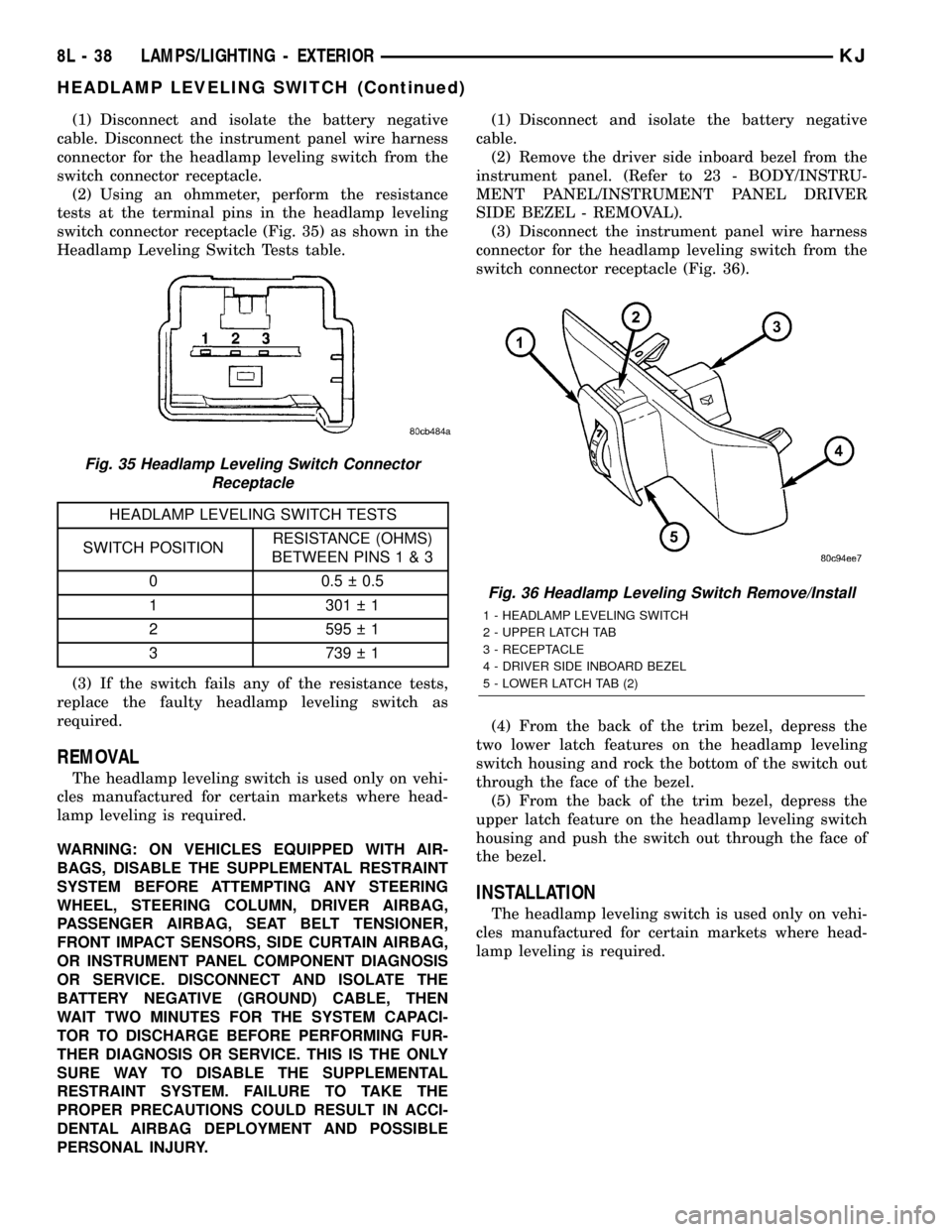headlamp JEEP LIBERTY 2002 KJ / 1.G Owner's Guide
[x] Cancel search | Manufacturer: JEEP, Model Year: 2002, Model line: LIBERTY, Model: JEEP LIBERTY 2002 KJ / 1.GPages: 1803, PDF Size: 62.3 MB
Page 478 of 1803

the center of the headlamp reflector and thoroughly
clean any fingerprints from the reflector.
(6) Push the mounting flange of the headlamp lev-
eling motor into the mounting hole on the back of
headlamp unit housing unit the motor is firmly
seated (Fig. 32).
(7) Rotate the headlamp leveling motor on the
back of the headlamp unit housing clockwise about
30 degrees.
(8) Reinstall the headlamp bulb into the headlamp
unit housing. (Refer to 8 - ELECTRICAL/LAMPS/
LIGHTING - EXTERIOR/HEADLAMP BULB -
INSTALLATION).
(9) Reconnect the battery negative cable.
HEADLAMP LEVELING
SWITCH
DESCRIPTION
The headlamp leveling switch (Fig. 34) is used only
on vehicles manufactured for certain markets where
the headlamp leveling system is required. The head-
lamp leveling switch is mounted in the driver side
inboard trim bezel on the instrument panel, where it
is secured by molded latch features that are integral
to the switch housing. Only the switch bezel and
thumbwheel are visible on the outer surface of the
instrument panel trim bezel. The black plastic switch
thumbwheel is marked with white numbers ª0,º ª1,º
ª2,º and ª3,º each of which indicates one of the four
switch detent positions. Each higher number repre-sents a lower aiming position of the headlamp beam
relative to the road surface. The black, molded plas-
tic switch housing has an integral connector recepta-
cle on the back, a single latch feature on the top, and
two latch features (one on each side) on the bottom.
The switch is connected to the vehicle electrical sys-
tem through a dedicated take out and connector of
the instrument panel wire harness. Within the
switch housing is the leveling switch circuitry includ-
ing the switch contacts and a series resistor configu-
ration.
The headlamp leveling switch cannot be adjusted
or repaired and, if faulty or damaged, the unit must
be replaced.
OPERATION
The headlamp leveling switch receives battery cur-
rent on a fused park lamp relay output circuit from a
fuse in the Junction Block (JB) whenever the park
lamp relay is energized (park lamps are turned On).
The switch receives a path to ground through a splice
block located in the instrument panel wire harness
with an eyelet terminal connector that is secured by
a nut to a ground stud on the driver side instrument
panel end bracket near the JB. The only output from
the switch is a voltage signal that it provides to the
headlamp leveling motors on a headlamp adjust sig-
nal circuit. Each switch position selects a different
tap on a series resistor within the switch to provide a
different voltage signal to the leveling motors. The
higher the switch position number, the higher the
output voltage level.
The headlamp leveling switch can be tested using
conventional diagnostic tools and methods.
DIAGNOSIS AND TESTING - HEADLAMP
LEVELING SWITCH
WARNING: ON VEHICLES EQUIPPED WITH AIR-
BAGS, DISABLE THE SUPPLEMENTAL RESTRAINT
SYSTEM BEFORE ATTEMPTING ANY STEERING
WHEEL, STEERING COLUMN, DRIVER AIRBAG,
PASSENGER AIRBAG, SEAT BELT TENSIONER,
FRONT IMPACT SENSORS, SIDE CURTAIN AIRBAG,
OR INSTRUMENT PANEL COMPONENT DIAGNOSIS
OR SERVICE. DISCONNECT AND ISOLATE THE
BATTERY NEGATIVE (GROUND) CABLE, THEN
WAIT TWO MINUTES FOR THE SYSTEM CAPACI-
TOR TO DISCHARGE BEFORE PERFORMING FUR-
THER DIAGNOSIS OR SERVICE. THIS IS THE ONLY
SURE WAY TO DISABLE THE SUPPLEMENTAL
RESTRAINT SYSTEM. FAILURE TO TAKE THE
PROPER PRECAUTIONS COULD RESULT IN ACCI-
DENTAL AIRBAG DEPLOYMENT AND POSSIBLE
PERSONAL INJURY.
Fig. 34 Headlamp Leveling Switch
1 - SWITCH
2 - UPPER LATCH FEATURE (1)
3 - CONNECTOR RECEPTACLE
4 - LOWER LATCH FEATURE (2)
5 - THUMBWHEEL
KJLAMPS/LIGHTING - EXTERIOR 8L - 37
HEADLAMP LEVELING MOTOR (Continued)
Page 479 of 1803

(1) Disconnect and isolate the battery negative
cable. Disconnect the instrument panel wire harness
connector for the headlamp leveling switch from the
switch connector receptacle.
(2) Using an ohmmeter, perform the resistance
tests at the terminal pins in the headlamp leveling
switch connector receptacle (Fig. 35) as shown in the
Headlamp Leveling Switch Tests table.
HEADLAMP LEVELING SWITCH TESTS
SWITCH POSITIONRESISTANCE (OHMS)
BETWEEN PINS1&3
0 0.5 0.5
1 301 1
2 595 1
3 739 1
(3) If the switch fails any of the resistance tests,
replace the faulty headlamp leveling switch as
required.
REMOVAL
The headlamp leveling switch is used only on vehi-
cles manufactured for certain markets where head-
lamp leveling is required.
WARNING: ON VEHICLES EQUIPPED WITH AIR-
BAGS, DISABLE THE SUPPLEMENTAL RESTRAINT
SYSTEM BEFORE ATTEMPTING ANY STEERING
WHEEL, STEERING COLUMN, DRIVER AIRBAG,
PASSENGER AIRBAG, SEAT BELT TENSIONER,
FRONT IMPACT SENSORS, SIDE CURTAIN AIRBAG,
OR INSTRUMENT PANEL COMPONENT DIAGNOSIS
OR SERVICE. DISCONNECT AND ISOLATE THE
BATTERY NEGATIVE (GROUND) CABLE, THEN
WAIT TWO MINUTES FOR THE SYSTEM CAPACI-
TOR TO DISCHARGE BEFORE PERFORMING FUR-
THER DIAGNOSIS OR SERVICE. THIS IS THE ONLY
SURE WAY TO DISABLE THE SUPPLEMENTAL
RESTRAINT SYSTEM. FAILURE TO TAKE THE
PROPER PRECAUTIONS COULD RESULT IN ACCI-
DENTAL AIRBAG DEPLOYMENT AND POSSIBLE
PERSONAL INJURY.(1) Disconnect and isolate the battery negative
cable.
(2) Remove the driver side inboard bezel from the
instrument panel. (Refer to 23 - BODY/INSTRU-
MENT PANEL/INSTRUMENT PANEL DRIVER
SIDE BEZEL - REMOVAL).
(3) Disconnect the instrument panel wire harness
connector for the headlamp leveling switch from the
switch connector receptacle (Fig. 36).
(4) From the back of the trim bezel, depress the
two lower latch features on the headlamp leveling
switch housing and rock the bottom of the switch out
through the face of the bezel.
(5) From the back of the trim bezel, depress the
upper latch feature on the headlamp leveling switch
housing and push the switch out through the face of
the bezel.
INSTALLATION
The headlamp leveling switch is used only on vehi-
cles manufactured for certain markets where head-
lamp leveling is required.
Fig. 35 Headlamp Leveling Switch Connector
Receptacle
Fig. 36 Headlamp Leveling Switch Remove/Install
1 - HEADLAMP LEVELING SWITCH
2 - UPPER LATCH TAB
3 - RECEPTACLE
4 - DRIVER SIDE INBOARD BEZEL
5 - LOWER LATCH TAB (2)
8L - 38 LAMPS/LIGHTING - EXTERIORKJ
HEADLAMP LEVELING SWITCH (Continued)
Page 480 of 1803

WARNING: ON VEHICLES EQUIPPED WITH AIR-
BAGS, DISABLE THE SUPPLEMENTAL RESTRAINT
SYSTEM BEFORE ATTEMPTING ANY STEERING
WHEEL, STEERING COLUMN, DRIVER AIRBAG,
PASSENGER AIRBAG, SEAT BELT TENSIONER,
FRONT IMPACT SENSORS, SIDE CURTAIN AIRBAG,
OR INSTRUMENT PANEL COMPONENT DIAGNOSIS
OR SERVICE. DISCONNECT AND ISOLATE THE
BATTERY NEGATIVE (GROUND) CABLE, THEN
WAIT TWO MINUTES FOR THE SYSTEM CAPACI-
TOR TO DISCHARGE BEFORE PERFORMING FUR-
THER DIAGNOSIS OR SERVICE. THIS IS THE ONLY
SURE WAY TO DISABLE THE SUPPLEMENTAL
RESTRAINT SYSTEM. FAILURE TO TAKE THE
PROPER PRECAUTIONS COULD RESULT IN ACCI-
DENTAL AIRBAG DEPLOYMENT AND POSSIBLE
PERSONAL INJURY.
(1) From the face of the driver side inboard bezel,
align the headlamp leveling switch housing to the
mounting hole in the bezel (Fig. 36).
(2) Push the headlamp leveling switch into the
mounting hole until it is fully seated and the upper
latch and two lower latch features on the switch
housing are engaged on the back of the bezel.
(3) Position the switch and bezel unit to the
instrument panel.
(4) Reconnect the instrument panel wire harness
connector for the headlamp leveling switch to the
switch connector receptacle.
(5) Reinstall the driver side inboard bezel onto the
instrument panel. (Refer to 23 - BODY/INSTRU-
MENT PANEL/INSTRUMENT PANEL DRIVER
SIDE BEZEL - INSTALLATION).
(6) Reconnect the battery negative cable.
HEADLAMP LOW BEAM RELAY
DESCRIPTION
The headlamp low beam relay is located in the
Junction Block (JB) below the driver side outboard
end of the instrument panel in the passenger com-
partment of the vehicle. The headlamp low beam
relay is a conventional International Standards
Organization (ISO) micro relay (Fig. 37). Relays con-
forming to the ISO specifications have common phys-
ical dimensions, current capacities, terminal
patterns, and terminal functions. The relay is con-
tained within a small, rectangular, molded plastic
housing and is connected to all of the required inputs
and outputs by five integral male spade-type termi-
nals that extend from the bottom of the relay base.
The headlamp low beam relay cannot be adjusted
or repaired and, if faulty or damaged, the unit must
be replaced.
OPERATION
The headlamp low beam relay is an electromechan-
ical switch that uses a low current input from the
Body Control Module (BCM) to control a high current
output to the headlamp low beam filaments. The
movable common feed contact point is held against
the fixed normally closed contact point by spring
pressure. When the relay coil is energized, an electro-
magnetic field is produced by the coil windings. This
electromagnetic field draws the movable relay con-
tact point away from the fixed normally closed con-
tact point, and holds it against the fixed normally
open contact point. When the relay coil is de-ener-
gized, spring pressure returns the movable contact
point back against the fixed normally closed contact
point. A resistor is connected in parallel with the
relay coil in the relay, and helps to dissipate voltage
spikes and electromagnetic interference that can be
generated as the electromagnetic field of the relay
coil collapses.
The headlamp low beam relay terminals are con-
nected to the vehicle electrical system through a con-
nector receptacle in the Junction Block (JB). The
inputs and outputs of the headlamp low beam relay
include:
²Common Feed Terminal- The common feed
terminal (30) receives battery current at all times
from a fuse in the Power Distribution Center (PDC)
through a fused B(+) circuit.
²Coil Ground Terminal- The coil ground termi-
nal (85) receives battery current at all times from a
fuse in the PDC through a fused B(+) circuit.
Fig. 37 ISO Micro Relay
30 - COMMON FEED
85 - COIL GROUND
86 - COIL BATTERY
87 - NORMALLY OPEN
87A - NORMALLY CLOSED
KJLAMPS/LIGHTING - EXTERIOR 8L - 39
HEADLAMP LEVELING SWITCH (Continued)
Page 481 of 1803

²Coil Battery Terminal- The coil battery ter-
minal (86) is connected to a control output of the
Body Control Module (BCM) through a low beam
relay control circuit. The BCM controls headlamp low
beam operation by controlling a ground path through
this circuit.
²Normally Open Terminal- The normally open
terminal (87) is connected to the headlamp low beam
filaments through the low beam relay output circuit
and provides battery current to the headlamp low
beams whenever the relay is energized.
²Normally Closed Terminal- The normally
closed terminal (87A) is not connected in this appli-
cation.
The headlamp low beam relay can be diagnosed
using conventional diagnostic tools and methods.
DIAGNOSIS AND TESTING - HEADLAMP LOW
BEAM RELAY
The headlamp low beam relay (Fig. 38) is located
in the Junction Block (JB) under the driver side out-
board end of the instrument panel. Refer to the
appropriate wiring information. The wiring informa-
tion includes wiring diagrams, proper wire and con-
nector repair procedures, details of wire harness
routing and retention, connector pin-out information
and location views for the various wire harness con-
nectors, splices and grounds.
WARNING: ON VEHICLES EQUIPPED WITH AIR-
BAGS, DISABLE THE SUPPLEMENTAL RESTRAINT
SYSTEM BEFORE ATTEMPTING ANY STEERING
WHEEL, STEERING COLUMN, DRIVER AIRBAG,
PASSENGER AIRBAG, SEAT BELT TENSIONER,
FRONT IMPACT SENSORS, SIDE CURTAIN AIRBAG,
OR INSTRUMENT PANEL COMPONENT DIAGNOSIS
OR SERVICE. DISCONNECT AND ISOLATE THE
BATTERY NEGATIVE (GROUND) CABLE, THEN
WAIT TWO MINUTES FOR THE SYSTEM CAPACI-
TOR TO DISCHARGE BEFORE PERFORMING FUR-
THER DIAGNOSIS OR SERVICE. THIS IS THE ONLY
SURE WAY TO DISABLE THE SUPPLEMENTAL
RESTRAINT SYSTEM. FAILURE TO TAKE THE
PROPER PRECAUTIONS COULD RESULT IN ACCI-
DENTAL AIRBAG DEPLOYMENT AND POSSIBLE
PERSONAL INJURY.
(1) Remove the headlamp low beam relay from the
JB. (Refer to 8 - ELECTRICAL/LAMPS/LIGHTING -
EXTERIOR/HEADLAMP LOW BEAM RELAY -
REMOVAL).
(2) A relay in the de-energized position should
have continuity between terminals 87A and 30, and
no continuity between terminals 87 and 30. If OK, go
to Step 3. If not OK, replace the faulty relay.(3) Resistance between terminals 85 and 86 (elec-
tromagnet) should be 75 8 ohms. If OK, go to Step
4. If not OK, replace the faulty relay.
(4) Connect a battery to terminals 85 and 86.
There should now be continuity between terminals
30 and 87, and no continuity between terminals 87A
and 30. If OK, reinstall the relay and use a DRBIIIt
scan tool to perform further testing. Refer to the
appropriate diagnostic information.
REMOVAL
WARNING: ON VEHICLES EQUIPPED WITH AIR-
BAGS, DISABLE THE SUPPLEMENTAL RESTRAINT
SYSTEM BEFORE ATTEMPTING ANY STEERING
WHEEL, STEERING COLUMN, DRIVER AIRBAG,
PASSENGER AIRBAG, SEAT BELT TENSIONER,
FRONT IMPACT SENSORS, SIDE CURTAIN AIRBAG,
OR INSTRUMENT PANEL COMPONENT DIAGNOSIS
OR SERVICE. DISCONNECT AND ISOLATE THE
BATTERY NEGATIVE (GROUND) CABLE, THEN
WAIT TWO MINUTES FOR THE SYSTEM CAPACI-
TOR TO DISCHARGE BEFORE PERFORMING FUR-
THER DIAGNOSIS OR SERVICE. THIS IS THE ONLY
SURE WAY TO DISABLE THE SUPPLEMENTAL
RESTRAINT SYSTEM. FAILURE TO TAKE THE
PROPER PRECAUTIONS COULD RESULT IN ACCI-
DENTAL AIRBAG DEPLOYMENT AND POSSIBLE
PERSONAL INJURY.
(1) Disconnect and isolate the battery negative
cable.
Fig. 38 ISO Micro Relay
30 - COMMON FEED
85 - COIL GROUND
86 - COIL BATTERY
87 - NORMALLY OPEN
87A - NORMALLY CLOSED
8L - 40 LAMPS/LIGHTING - EXTERIORKJ
HEADLAMP LOW BEAM RELAY (Continued)
Page 482 of 1803

(2) Remove the steering column opening cover
from the instrument panel. (Refer to 23 - BODY/IN-
STRUMENT PANEL/STEERING COLUMN OPEN-
ING COVER - REMOVAL).
(3) Remove the headlamp low beam relay by
grasping it firmly and pulling it straight out from the
receptacle in the Junction Block (JB) (Fig. 39).
INSTALLATION
WARNING: ON VEHICLES EQUIPPED WITH AIR-
BAGS, DISABLE THE SUPPLEMENTAL RESTRAINT
SYSTEM BEFORE ATTEMPTING ANY STEERING
WHEEL, STEERING COLUMN, DRIVER AIRBAG,
PASSENGER AIRBAG, SEAT BELT TENSIONER,
FRONT IMPACT SENSORS, SIDE CURTAIN AIRBAG,
OR INSTRUMENT PANEL COMPONENT DIAGNOSIS
OR SERVICE. DISCONNECT AND ISOLATE THE
BATTERY NEGATIVE (GROUND) CABLE, THEN
WAIT TWO MINUTES FOR THE SYSTEM CAPACI-
TOR TO DISCHARGE BEFORE PERFORMING FUR-THER DIAGNOSIS OR SERVICE. THIS IS THE ONLY
SURE WAY TO DISABLE THE SUPPLEMENTAL
RESTRAINT SYSTEM. FAILURE TO TAKE THE
PROPER PRECAUTIONS COULD RESULT IN ACCI-
DENTAL AIRBAG DEPLOYMENT AND POSSIBLE
PERSONAL INJURY.
(1) Position the headlamp low beam relay to the
proper receptacle in the Junction Block (JB) (Fig. 39).
(2) Align the headlamp low beam relay terminals
with the terminal cavities in the JB receptacle.
(3) Push firmly and evenly on the top of the head-
lamp low beam relay until the terminals are fully
seated in the terminal cavities in the JB receptacle.
(4) Reinstall the steering column opening cover
onto the instrument panel. (Refer to 23 - BODY/IN-
STRUMENT PANEL/STEERING COLUMN OPEN-
ING COVER - INSTALLATION).
(5) Reconnect the battery negative cable.
HEADLAMP UNIT
REMOVAL
(1) Disconnect and isolate the battery negative
cable.
(2) Remove the grille panel from the grille opening
reinforcement. (Refer to 23 - BODY/EXTERIOR/
GRILLE - REMOVAL).
(3) Remove the two screws that secure the mount-
ing tabs on the inboard side of the headlamp unit
housing to the grille opening reinforcement (Fig. 40).
(4) Pull the inboard side of the headlamp unit
away from the grille opening reinforcement farFig. 39 Junction Block - Inboard Side (LHD Shown -
Rotate 180É for RHD)
1 - PASSENGER DOOR UNLOCK RELAY
2 - JB C3 CONNECTOR RECEPTACLE
3 - LOW BEAM RELAY
4 - CIRCUIT BREAKER #1
5 - CIRCUIT BREAKER #2
6 - CIRCUIT BREAKER #3
7 - DOOR LOCK RELAY
8 - DEFOGGER RELAY
9-SPARE
10 - FRONT FOG LAMP RELAY
11 - HORN RELAY
12 - SPARE
13 - SPARE
14 - REAR FOG LAMP RELAY
15 - PARK LAMP RELAY
16 - DRIVER DOOR UNLOCK RELAY
17 - JB C1 CONNECTOR RECEPTACLE
18 - JB C2 CONNECTOR RECEPTACLE
Fig. 40 Headlamp Unit Remove/Install
1 - FENDER PANEL
2 - HEADLAMP UNIT
3 - MOUNTING TAB (2)
4 - MOUNTING PANEL
5 - LOCATOR TAB
KJLAMPS/LIGHTING - EXTERIOR 8L - 41
HEADLAMP LOW BEAM RELAY (Continued)
Page 483 of 1803

enough to disengage the locator tab on the outboard
side of the unit (Fig. 41) or (Fig. 42) from the engage-
ment slot in the outboard edge of the reinforcement.
(5) Pull the headlamp unit away from the grille
opening reinforcement far enough to disconnect the
wire harness connectors from the headlamp bulbsocket (North America), the headlamp bulb base
(Rest-Of-World), the front position lamp socket (if
equipped), and the headlamp leveling motor (if
equipped).
(6) Remove the headlamp unit from the grille
opening reinforcement.
INSTALLATION
(1) Position the headlamp unit to the grille open-
ing reinforcement.
(2) Reconnect the wire harness connectors to the
headlamp bulb socket (North America), the headlamp
bulb base (Rest-Of-World), the front position lamp
socket (if equipped), and the headlamp leveling motor
(if equipped) (Fig. 41) or (Fig. 42).
(3) Engage the locator tab on the outboard side of
the headlamp unit into the engagement slot in the
outboard edge of the grille opening reinforcement.
(4) Align the two mounting tabs on the inboard
side of the headlamp unit housing to the mounting
holes in the grille opening reinforcement (Fig. 40).
(5) Install and tighten the two screws that secure
the mounting tabs on the inboard side of the head-
lamp unit housing to the grille opening reinforce-
ment. Tighten the screws to 3 N´m (30 in. lbs.).
(6) Reinstall the grille panel onto the grille open-
ing reinforcement. (Refer to 23 - BODY/EXTERIOR/
GRILLE - INSTALLATION).
(7) Reconnect the battery negative cable.
(8) Confirm proper headlamp unit alignment.
(Refer to 8 - ELECTRICAL/LAMPS/LIGHTING -
EXTERIOR/HEADLAMP UNIT - ADJUSTMENTS).
ADJUSTMENTS
ADJUSTMENT - HEADLAMP UNIT
VEHICLE PREPARATION FOR HEADLAMP ALIGNMENT
(1) Verify headlamp dimmer (multi-function)
switch and high beam indicator operation.
(2) If the vehicle is equipped with headlamp level-
ing, be certain that the headlamp leveling switch is
in the ª0º position.
(3) Repair or replace any faulty or damaged com-
ponents that could hinder proper lamp alignment.
(4) Verify proper tire inflation.
(5) Clean headlamp lenses.
(6) Verify that cargo area is not heavily loaded.
(7) The fuel tank should be Full. Add 2.94 kilo-
grams (6.5 pounds) of weight over the fuel tank for
each estimated gallon of missing fuel.
HEADLAMP ALIGNMENT SCREEN PREPARATION
Prepare an alignment screen as illustrated.
(1) Position the vehicle on a level surface perpen-
dicular to a flat wall 7.62 meters (25 feet) away from
Fig. 41 Headlamp Unit - North America
1 - MOUNTING TAB (2)
2 - ADJUSTING SCREW
3 - LOCK RING
4 - HOUSING
5 - LOCATOR TAB
6 - SOCKET & BULB
Fig. 42 Headlamp Unit - Rest-Of-World
1 - LEVELING MOTOR (IF EQUIPPED)
2 - BOOT SEAL
3 - ADJUSTING SCREW
4 - LOCATOR TAB
5 - HOUSING
6 - FRONT POSITION LAMP SOCKET & BULB
7 - HEADLAMP BULB
8 - MOUNTING TAB (2)
8L - 42 LAMPS/LIGHTING - EXTERIORKJ
HEADLAMP UNIT (Continued)
Page 484 of 1803

the front of the headlamp lens for North American
vehicles, or 10.0 meters (32.81 feet) away from the
front of the headlamp lens for Rest-Of-World vehicles
(Fig. 43). If necessary, tape a line on the floor at the
appropriate distance away from and parallel to the
wall.
(2) Measure up on the wall 1.27 meters (5 feet)
from the floor and tape a vertical line on the align-
ment screen at the centerline of the vehicle. Sight
along the centerline of the vehicle (from the rear of
the vehicle forward) to verify the accuracy of the cen-
terline placement.
(3) Rock the vehicle from side-to-side three times
to allow the suspension to stabilize, then jounce the
front suspension three times by pushing downward
on the front bumper and releasing. Measure the dis-
tance from the center of the headlamp lens to the
floor. Transfer this measurement to the alignment
screen and tape a horizontal line on the wall at this
mark. This line will be used for up-and-down adjust-
ment reference.(4) Measure the distance from the centerline of the
vehicle to the center of each headlamp being aligned.
Transfer these measurements to the alignment
screen and tape a vertical line this distance to each
side of the vehicle centerline. These lines will be used
for left/right reference.
HEADLAMP ADJUSTMENT
A properly aligned headlamp will project a pattern
on the alignment screen from just below horizontal to
75 millimeters (3 inches) below the headlamp center-
line for vehicles in North America, or from just below
horizontal to 125 millimeters (5 inches) below the
headlamp horizontal centerline for vehicles in Rest-
Of-World.
(1) Vehicles for all markets except Japan should
have the headlamp low beams selected with the dim-
mer (multi-function) switch during the adjustment
procedure. Vehicles for the Japanese market should
have the headlamp high beams selected.
(2) Cover the lens of the headlamp that is not
being adjusted.
Fig. 43 Headlamp Alignment Screen - Typical
1 - CENTER OF VEHICLE TO CENTER OF HEADLAMP LENS
2 - FLOOR TO CENTER OF HEADLAMP LENS
3 - 7.62 METERS (25 FEET) NORTH AMERICA/10.0 METERS
(32.81 FEET) REST-OF-WORLD4 - FRONT OF HEADLAMP
5 - VEHICLE CENTERLINE
KJLAMPS/LIGHTING - EXTERIOR 8L - 43
HEADLAMP UNIT (Continued)
Page 485 of 1803

(3) Turn the adjusting screw (Fig. 44) until the top
edge of the beam intensity pattern is positioned from
just below horizontal to 75 millimeters (3 inches)
below the headlamp horizontal centerline for vehicles
in North America, or from just below horizontal to
125 millimeters (5 inches) below the headlamp hori-
zontal centerline for vehicles in Rest-Of-World.
(4) Repeat the adjustment procedure for the oppo-
site headlamp.
LICENSE PLATE LAMP BULB
REMOVAL
NORTH AMERICA
(1) Disconnect and isolate the battery negative
cable.
(2) Reach through the opening in the rear bumper
fascia between the license plate and the lamp to
access and firmly grasp the socket on the back of the
license plate lamp unit housing (Fig. 45).
(3) Pull the socket and bulb straight out of the
back of the license plate lamp unit housing.
(4) Pull the bulb straight out of the license plate
lamp unit socket.
REST-OF-WORLD
(1) Disconnect and isolate the battery negative
cable.
(2) Unsnap and lift up the bottom of the license
mounting plate far enough to access and remove the
two screws that secure the license plate bracket to
the special lug nuts on the spare tire (Fig. 46).(3) Swing the license plate bracket away from the
spare tire far enough to access the license plate lamp
bulb sockets.
(4) Firmly grasp the socket on the top of the
license plate lamp unit housing for the bulb that is
being removed (Fig. 47).
(5) Rotate the socket on the top of the license plate
lamp unit housing counterclockwise about 30
degrees.
(6) Pull the socket and bulb straight out of the top
of the license plate lamp unit housing.
Fig. 44 Headlamp Adjusting Screw
1 - HEADLAMP UNIT
2 - FENDER PANEL
3 - ADJUSTING SCREW ACCESS HOLE
4 - UPPER RADIATOR CROSSMEMBER
Fig. 45 License Plate Lamp Bulb Remove/Install -
North America
1 - REAR BUMPER FASCIA
2 - LICENSE PLATE LAMP
3 - SOCKET
4 - BULB
Fig. 46 License Plate Bracket - Rest-Of-World
1 - SPARE TIRE
2 - SPECIAL LUG NUT (2)
3 - LICENSE PLATE BRACKET
4 - SCREW (2)
8L - 44 LAMPS/LIGHTING - EXTERIORKJ
HEADLAMP UNIT (Continued)
Page 488 of 1803

stalk can also be pulled outward to select those
lamps. Each control stalk also features a knurled
control ring located just below the control knob. The
left control stalk is dedicated to providing driver con-
trols for the interior and exterior lighting systems,
while the right control stalk is dedicated to providing
driver controls for the front and rear wiper systems.
Two integral connector receptacles on the forward
facing surface of the multi-function switch housing
connect the switch two the vehicle electrical system
through two take outs and connectors of the instru-
ment panel wire harness. The left connector recepta-
cle contains nine terminal pins for the lighting
control circuits of the switch, while the right connec-
tor receptacle contains six terminal pins for the
wiper control circuits of the switch. The multi-func-
tion switch cannot be adjusted or repaired and, if
faulty or damaged, it must be replaced.
LEFT CONTROL STALK The left (lighting) control
stalk of the multi-function switch supports the fol-
lowing functions and features:
²Front Fog Lamps- For vehicles so equipped,
the internal circuitry and hardware of the multi-
function switch left (lighting) control stalk provide
detent switching for the optional front fog lamps.
²Headlamps- The internal circuitry and hard-
ware of the multi-function switch left (lighting) con-
trol stalk provide detent switching for the
headlamps.²Headlamp Beam Selection- The internal cir-
cuitry and hardware of the multi-function switch left
(lighting) control stalk provide detent switching for
selection of the headlamp high or low beams.
²Headlamp Optical Horn- The internal cir-
cuitry and hardware of the multi-function switch left
(lighting) control stalk includes momentary switching
of the headlamp high beam circuits to provide an
optical horn feature (sometimes referred to as flash-
to-pass), which allows the vehicle operator to momen-
tarily flash the headlamp high beams as an optical
signalling device.
²Interior Lamps Defeat- The internal circuitry
and hardware of the multi-function switch left (light-
ing) control stalk provide detent switching to defeat
the illumination of all interior courtesy lamps when a
door, the rear flip-up glass, or the tailgate are
opened.
²Interior Lamps On- The internal circuitry and
hardware of the multi-function switch left (lighting)
control stalk provide detent switching to simulta-
neously illuminate all interior courtesy lamps.
²Panel Lamps Dimming- The internal cir-
cuitry and hardware of the multi-function switch left
(lighting) control stalk provide simultaneous adjust-
able control of the illumination intensity of all instru-
ment panel lighting at one of six available
illumination intensity levels.
²Parade Mode- The internal circuitry and hard-
ware of the multi-function switch left (lighting) con-
Fig. 50 Multi-Function Switch
1 - MULTI-FUNCTION SWITCH
2 - RIGHT (WIPER) CONTROL STALK
3 - LEFT (LIGHTING) CONTROL STALK
4 - TURN SIGNAL CANCEL ACTUATOR
5 - RIGHT (WIPER) CONTROL KNOB6 - RIGHT (WIPER) CONTROL RING
7 - LEFT (LIGHTING) CONTROL RING
8 - LEFT (LIGHTING) CONTROL KNOB
KJLAMPS/LIGHTING - EXTERIOR 8L - 47
MULTI-FUNCTION SWITCH (Continued)
Page 489 of 1803

trol stalk provide detent switching for a parade mode
that maximizes the illumination intensity of all
instrument panel lighting for visibility when driving
in daylight with the exterior lamps turned on.
²Park Lamps- The internal circuitry and hard-
ware of the multi-function switch left (lighting) con-
trol stalk provide detent switching for the park
lamps.
²Rear Fog Lamps- For vehicles so equipped,
the internal circuitry and hardware of the multi-
function switch left (lighting) control stalk provide
detent switching for the optional rear fog lamps.
Rear fog lamps are optional only for vehicles manu-
factured for certain markets, where they are
required.
²Turn Signal Control- The internal circuitry
and hardware of the multi-function switch left (light-
ing) control stalk provide both momentary non-detent
switching and detent switching with automatic can-
cellation for both the left and right turn signal
lamps.
RIGHT CONTROL STALK The right (wiper) con-
trol stalk of the multi-function switch supports the
following functions and features:
²Continuous Front Wipe Modes- The internal
circuitry and hardware of the multi-function switch
right (wiper) control stalk provide two continuous
front wipe switch positions, low speed or high speed.
²Continuous Rear Wipe Mode- The internal
circuitry and hardware of the multi-function switch
right (wiper) control stalk provide one continuous
rear wipe switch position.
²Front Washer Mode- The internal circuitry
and hardware of the multi-function switch right
(wiper) control stalk switch provide front washer sys-
tem operation.
²Front Wipe-After-Wash Mode- The internal
circuitry and hardware of the multi-function switch
right (wiper) control stalk provide a wipe-after-wash
mode.
²Front Wiper Mist Mode- The internal cir-
cuitry and hardware of the multi-function switch
right (wiper) control stalk provide a front wiper sys-
tem mist mode.
²Intermittent Front Wipe Mode- The internal
circuitry and hardware of the multi-function switch
right (wiper) control stalk provide an intermittent
front wipe mode with five delay interval positions.
²Intermittent Rear Wipe Mode- The internal
circuitry and hardware of the multi-function switch
right (wiper) control stalk provide one fixed interval
intermittent rear wipe mode switch position.
²Rear Washer Mode- The internal circuitry and
hardware of the multi-function switch right (wiper)
control stalk provide rear washer system operation.OPERATION
The multi-function switch uses a combination of
resistor multiplexed and conventionally switched out-
puts to control the many functions and features it
provides. The switch receives battery current on a
fused ignition switch output (run-acc) circuit from a
fuse in the Junction Block (JB) whenever the ignition
switch is in the On or Accessory positions. The switch
receives a path to ground at all times through a
splice block located in the instrument panel wire har-
ness with an eyelet terminal connector that is
secured by a nut to a ground stud on the driver side
instrument panel end bracket near the Junction
Block (JB). Following are descriptions of how each of
the two multi-function switch control stalks operate
to control the functions and features they provide.
LEFT CONTROL STALK The left (lighting) control
stalk of the multi-function switch operates as follows:
²Front Fog Lamps- For vehicles so equipped,
the control knob on the end of the multi-function
switch left (lighting) control stalk is pulled outward
to activate the optional front fog lamps. The control
knob is mechanically keyed so that it cannot be
pulled outward unless it is first rotated to turn on
the exterior lighting. The multi-function switch pro-
vides a resistor multiplexed output to the Body Con-
trol Module (BCM) on a fog lamp switch sense
circuit, and the BCM responds by energizing or de-
energizing the front fog lamp relay in the Junction
Block (JB) as required.
²Headlamps- The control knob on the end of
the multi-function switch left (lighting) control stalk
is rotated forward (counterclockwise) to its second
detent position to activate the headlamps. The multi-
function switch provides a resistor multiplexed out-
put to the Body Control Module (BCM) on a
headlamp switch sense circuit, and the BCM
responds by energizing or de-energizing the selected
low or high beam relay (Daytime Running Lamp
relay in Canadian vehicles) in the Junction Block
(JB) as required.
²Headlamp Beam Selection- The left (lighting)
control stalk of the multi-function switch is pulled
towards the steering wheel past a detent to actuate
the integral beam select switch circuitry. Each time
the control stalk is activated in this manner, the
opposite headlamp beam from what is currently
selected will be energized. The multi-function switch
provides a ground output to the Body Control Module
(BCM) on a high beam switch sense circuit, and the
BCM responds by energizing or de-energizing the
selected low or high beam relay (Daytime Running
Lamp relay in Canadian vehicles) in the Junction
Block (JB) as required.
²Headlamp Optical Horn- The left (lighting)
control stalk of the multi-function switch is pulled
8L - 48 LAMPS/LIGHTING - EXTERIORKJ
MULTI-FUNCTION SWITCH (Continued)